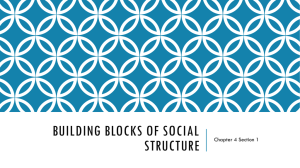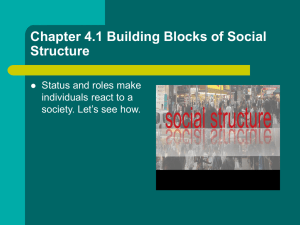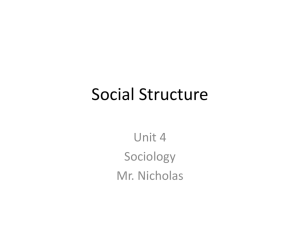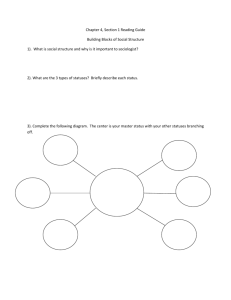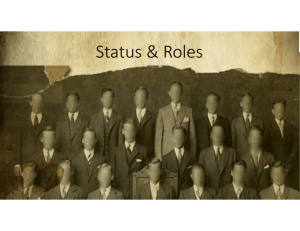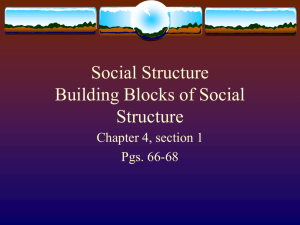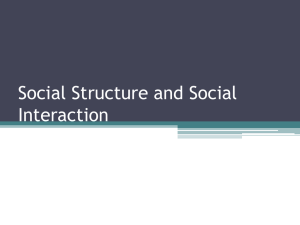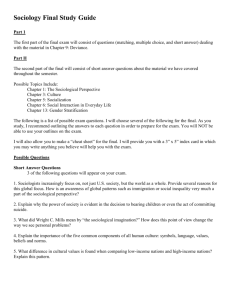4.1 Social Structure - coachclendenin
advertisement
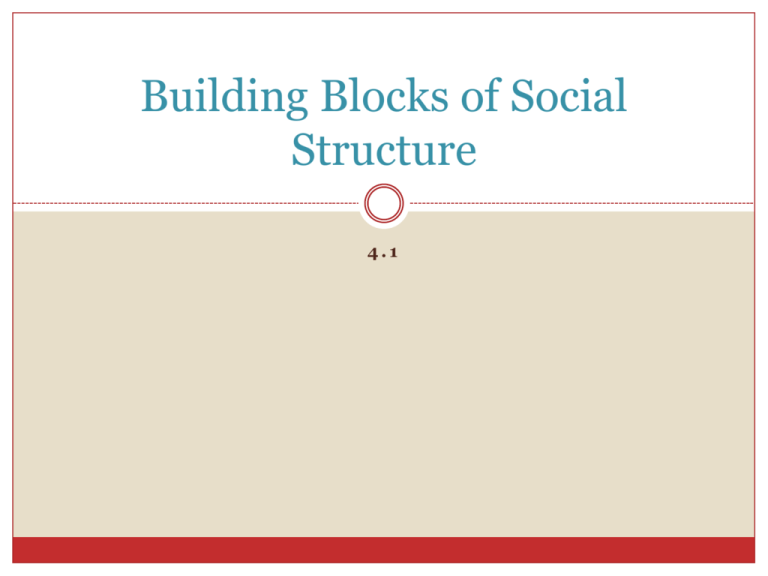
Building Blocks of Social Structure 4.1 Social Structure Social structure gives a society its enduring characteristics and makes patterns of human interaction predictable Sociologist view society as a system of interrelated parts, as structure since Comte Social structure: network of interrelated statuses and roles that guide human interaction Status: socially defined position in a group or in a society Roles: the behavior- the rights and obligations expected of someone occupying a particular status Ascribed Status Each individual in society occupies several statuses Father, husband, teacher, coach, spiritual leader of family Define where individuals fit in society and how they relate to others in society What is your status……..? Ascribed status: assigned according to qualities beyond a person’s control Inherited traits: race, nationality etc Reach a certain age: teenager, young adult, adult Did nothing to earn it Cannot change it Other ascribed statuses……? Achieved Status Achieved status: acquired through the individuals own direct efforts Have control over achieved status All occupations can be achieved status in U.S Special skills and knowledge Special abilities Becoming a sports star Becoming a lawyer Husband Wife Master Status Master Status: all individuals hold many statuses; one status may rank above all others….master status Can be achieved or ascribed U.S. adult’s master status is usually achieved Occupation, wealth, marital status, or parenthood Changes over course of life Teenage years-student or athlete Adulthood- based on occupation Late adulthood- being a grandparent or past accomplishments Roles Roles: component of social structure that bring statuses to life Occupy a status, play a role Play many different roles during the day What roles do you play…… at school/at home/friends? Reciprocal roles: corresponding roles that define the patterns of interaction between related statuses Can not be a husband without a wife Can not be a parent with out a child Doctor patient Role Expectations Role expectations: socially determined behavior expected of a person performing a role People interact with one another their behavior corresponds to the particular roles they are playing Parents provide love and nurturing for their children Police uphold the law Children respect parents and adults Role Performance Role performance: actual role behavior- does not match the behavior expected by society Problems arise because role behaviors considered appropriate by a certain segment of society are seen as inappropriate by society as a whole May try to fulfill the role but may fall short of expectations Problem occurs because each of us is asked to perform many roles, some of which are contradictory Parents mistreat their children Doctors do not provide the best care for their patients Role Set/Conflict Single status, still many interrelated roles to perform Role set: different roles attached to a single status Wear many “hats”!!! Role conflict: fulfilling the role expectations of one status makes it difficult to fulfill the role expectations of another role Be good employee, got to go to work, but to be a good parent one needs to be home and take care of a sick child Role strain: occurs when a person has difficulty meeting the role expectations of a single status Maintain morale by a boss when having the employees work long hours Social Institutions: statuses and roles organized to satisfy one or more of the basic needs of society Basic Needs of Society Physical and emotional support Transmitting knowledge Producing goods and services Maintaining social control Social Institutions: Media Medicine Science Family Religion Education politics
